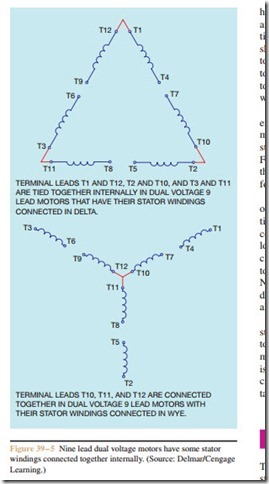Dual Voltage Connections
Motors that are intended to operate on two voltages, such as 240 or 480 volts, contain two separate windings for each phase (Figure 39 – 4). Notice that dual volt- age motors actually contain 12 T leads. Dual voltage motors not intended for wye-delta connection will have certain terminals tied internally, as shown in Figure 39 – 5. Although all three-phase dual voltage mo- tors actually contain 12 T leads, only terminal leads T1 through T9 are brought out to the terminal connection box for motors not intended for wye-delta starting.
If the motor is to be operated on the higher voltage, the stator leads will be connected in series, as shown in Figure 39 – 6. If the motor is to be connected for operation on the lower voltage, the stator windings will be connected in parallel as shown in Figure 39 – 7.
Although dual voltage motors designed for wye- delta starting will supply all 12 T leads at the terminal connection box, it will be necessary to make the proper connections for high or low voltage. The connection diagrams for dual voltage motors with 12 T leads are shown in Figure 39 – 8. Note that the diagrams do not show connection to power leads. These connections are made as part of the control circuit.
